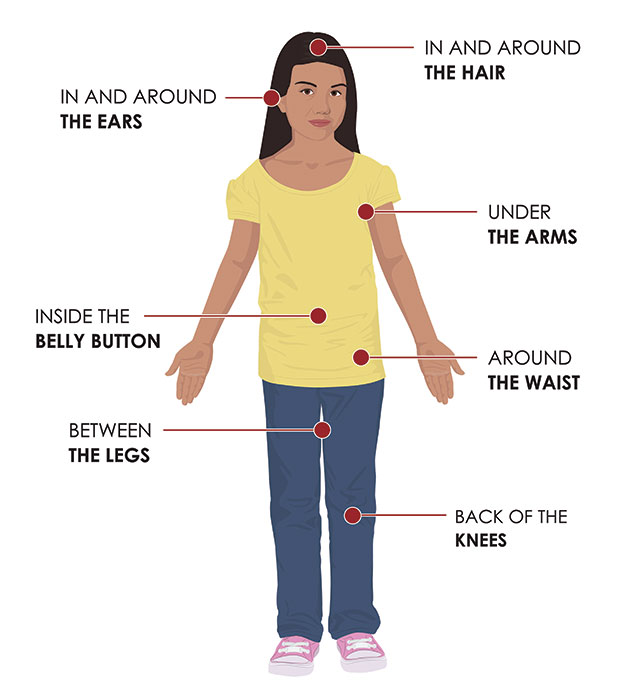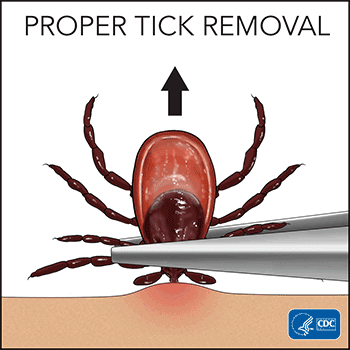The Virginia Department of Health (VDH) is requesting your help to further our understanding of tick ecology in Virginia. Our goal is to better understand which ticks are biting humans as well as the spatial distribution of Virginia's tick species.
How can you help? If you find a tick or ticks on your person or a family member, safely remove it, complete a corresponding survey, and mail it to VDH. Your participation in this project will significantly help develop the picture of tick ecology and risk of tick-borne diseases in Virginia. This service is available year-round and you are welcome to submit multiple surveys.
If you have questions about the survey please email: va.ticksurvey@vdh.virginia.gov
**VDH will only be identifying the species of ticks removed from humans. VDH will NOT test ticks for germs or identify ticks removed from pets or other animals.**
Step 1: Find and safely remove ticks
|
|
|
- After outdoor activity, inspect clothes and body for ticks. Remember to check in armpits, in and around ears and hair, belly button, backs of knees, and in between legs. Inspect children, clothing, and gear. Although VDH is not accepting ticks removed from pets, do not forget to check your furry family members as well.
- If you find a tick- use a tweezer to grasp the tick as close as possible to the skin.
- Pull upwards, with steady even pressure, until the tick releases to avoid breaking the mouth-parts of the tick or rupturing the tick's body.
- After tick removal, clean the skin and bite area with rubbing alcohol or soap and warm water.
- Save your tick in a bag or small container with rubbing alcohol to kill and sanitize the tick. Follow the instructions in Step 2 to submit for identification. Never crush a tick with your fingers.
- Be aware of when your tick exposure occurred in case an illness develops in the following days to weeks.
Step 2: Complete Tick Survey
Our quick 'Tick Survey' can be completed on a computer or mobile device. This will give us an idea of what tick or ticks you may have found and allow us to notify you of your results. To access the survey, please click on the survey image or scan the QR code with your smartphone below:
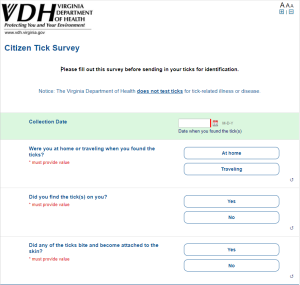 |
 |
Step 3: Submit tick photos to VDH (Optional)
Important Note: We have included the option to upload photos of your specimens as COVID-19 (Coronavirus) may cause delays in the tick identification process. Please make sure to fill out the survey and follow the directions below.
**The team will still be accepting mailed-in specimens, as the quality of the picture may not allow for proper identification.
How to take and submit pictures of your tick(s):
Step 1) Place the tick on a light-colored background and make sure you have good lighting. Clear two-sided tape can be used to secure the tick to keep it in focus.
Step 2) Move your camera or smart phone close to the tick and adjust the focus and so that the picture is not blurry. You may need to back away from the tick and use the digital zoom on your phone or camera to get the best picture possible.
You want to have a large picture of the tick with as much detail as possible (this helps with identification).
Step 3) Take picture #1
Step 4) Flip the tick over so the opposite side is now upwards.
Step 5) Follow Step 2 for taking a picture.
Step 6) Take picture #2
Step 7) Repeat this process for each tick.
Step 8) Submit pictures along with your survey ID # from your completed survey and hit the submit button:
Tick Picture Upload Form
Photograph Tips:
If the tick is swollen, concentrate your picture on the tick's “face” and shield area.
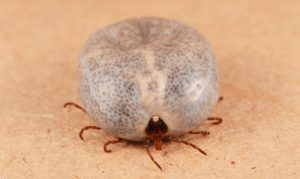
Photograph by Lyle Buss
If the tick is flat, concentrate the picture to include the entire top of the tick.
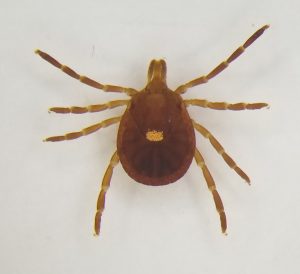
Photograph by Joshua Bernick
Step 4: Submit the tick specimen(s) to VDH
To submit tick(s) to VDH, place the tick(s) inside a sealed, zipper locked, bag or leak-proof container. Place the bag or container in an envelope, ideally a protective bubble envelope. There is no need to add alcohol or preservative when submitting the tick. Include a note clearly labeled with your email address and survey submission number (emailed after survey completion).
Address to:
ATTN: Elizabeth Forrey
VDH Office of Epidemiology
109 Governor St, 5th Floor RM 531B
Richmond, VA 23219
Step 5: What to expect after tick submission
Upon completion of the survey, expect an automated email with your survey ID, to be included upon submission of your tick(s), and other helpful information.
Our entomology team members are eager to identify the tick species. Expect to be emailed the results of the tick species within 10-14 days of submission. Check out our interactive map to view data gathered by all participants.
FAQ
What is citizen science?
Citizen science involves the public in scientific research. VDH is interested to better understand tick ecology throughout the Commonwealth. Our small entomology team frequently travels to collect ticks by dragging methods. However, we look to expand our knowledge as to which species bite humans; critical information to understand disease risk. We look forward to your involvement and appreciate your participation in these efforts.
What diseases can ticks transmit and which ticks are common in VA?
Ticks and Tick-borne Disease in Virginia Flyer

